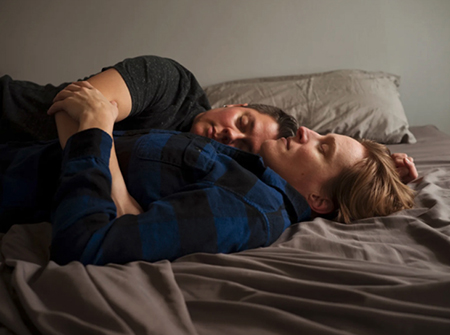
Continuing through January 5, 2024
At first glance, the hushed intimacy of Jess T. Dugan’s portraits might seem ill-suited to [CONTAINER]’s soaring, two-story atrium, an adjunct to Turner Carroll’s long-established Canyon Road flagship. Since its inception a year ago, [CONTAINER] has played host to sprawling sculptural and new-media shows, most recently Matt King’s phantasmagorical “Becoming Light,” whose Meow Wolf-themed exhibition design had no problem filling the cavernous inner courtyard and mezzanine. A judiciously tasteful install, however, has transformed the gestalt. The gallery feels compact, even cozy, while still fully utilizing the ambitious 20-by-40-foot entry wall. That wall has been painted a calming charcoal gray, subtly grounding ten of Dugan’s photographic prints, installed in an irregular pattern, recalling the casual offhandedness of a scrapbook.
St. Louis-based Dugan, who identifies as queer/nonbinary and uses they/them pronouns, has assembled a suite of portraits and still lifes, all from 2018-2023, that showcase a curated slice of their life, loves, friends, and favored locales. As autobiographical work, it follows in the lineage of such photographers as Nan Goldin, Sally Mann, Robert Mapplethorpe, Shen Wei, Larry Clark, Catherine Opie (one of Dugan’s most significant influences), and Dawoud Bey (with whom they studied at Columbia College/Chicago). Some of those photographers foregrounded transgressive aspects of their milieux — nudity, drug use, sadomasochism — but Dugan is not concerned with transgression per se. While many of their subjects are queer, transitioning, or transitioned, the portraits do not focus on, much less fetishize, gender identity. They get at something more universal: the struggle for self-definition, which we all go through at one time or another, and the basic human need, as E.M. Forster enjoined to “only connect.”
Dugan captures their sitters, standers, and floaters (many are in the water) in natural light, always using a tripod, working slowly to impart a sense of naturalism and serenity. Each subject has an open expression, never posed, self-possessed but not aloof, strong but not cocky, and above all trusting of the person behind the lens: “Jo at Sunset” with hands thoughtfully behind their back; “Kalven at Sunset” at medium distance in a field, wearing overalls, rolling up sleeves, and privately contemplative; and the artist’s own shirtless, eyes-closed “Self-portrait (Reaching).” Some shots are mildly suggestive: model Colin in one image poses recumbent on a bed of flowers and grass, and, in another, bares his chest and pubes while clutching a red bath towel in a red room. Cai exposes hirsute armpits and chest scars. JD and Steve are locked in a fond embrace. And Dugan themself with arm wrapped protectively around spouse, Vanessa. These are vignettes about companionship, touch, and love that cannot be ghettoized as, nor do they aspire to be, “queer photography.”
In fact, two of the exhibition’s most affecting works, both on video, speak to two of the widest-ranging emotional rites of passage so many of us wrestle with in our family lives: navigating fraught relationships with our parents and trying to shepherd our children through the minefields of growing up. “Letter to my Father” (2017, 14 minutes, 54 seconds) is by turns a tender and heartbreaking open letter to the artist’s father, who had rejected them after they came out as nonbinary. Dugan narrates the soundtrack while snapshots from their childhood and early adulthood unspool across the screen. The sunny images belie the text, which chronicles a trajectory toward estrangement. “Looking back,” one passage goes, “I always knew I embarrassed you. You always wanted me to be something I was not, and it was painful for you when others reacted to my masculinity, calling attention to a truth we were all trying to ignore.” This is tough stuff, raw and not sugarcoated.
Then there is “Letter to my Daughter” (2023, 16 minutes), which in similar slideshow/voiceover format takes on the challenges of pregnancy, miscarriage, childbirth, and parenting, some of the tribulations specific to queer parents, others to parents in general. Both videos show Dugan as a writer of gripping prose and crystalline introspection, and harboring a willingness to share experiences that are incredibly personal and painful.
That propensity is also evident in a photo book that rounds out the interdisciplinary exhibition, “Look at me like you love me” (MACK, 2022). Many of the show’s images are complemented by diaristic writings dealing with the nature of attraction, the power of place, and the sometimes grave difficulties faced by people with body dysphoria (one sitter in the book has since taken their own life). Dugan’s final diary entry functions as a credo for their central aesthetic mission to chronicle “relationships: the ebb and flow, the mutual support, the constant presence. The willingness to embark on a journey full of risk. The ever-present possibility of loss is made greater with the passage of time. The increasing depth of shared history, of lives lived together.”
In counterpoint to the portraits, still lifes such as “Window at Sunrise,” “Tulips,” and “Wisteria” abound. Their misty atmospherics underlie a crackling potential energy you can almost feel, like static electricity. The mises-en-scène of the still lifes as well as the portraits contribute to the narratives embedded within them. Many incorporate waterscapes: a lazy creek in “Enrique at Sunset,” an ocean beach in “Cai,” an undefined natural pool in “Dario.” Thematically, the artist returns to water frequently as a symbol of fluidity in all its forms. Skyscapes are also linked with the expansiveness of gender itself. In these, not a narrow corridor but an unlimited, wide-open horizon vaults upwards.
Across the whole of the show, what comes across most is the charged stillness of Dugan’s vision: serenity on the surface, complexity underneath, by turns resting and roiling. Their formal control is formidable, but Dugan’s overarching empathy with their subjects keeps the work from hermeticism. This is the work of a master technician but also a poet of natural light, a sculptor of narrative images, and a courageous sharer of self. Dugan is an artist in whom vulnerability and fearlessness merge.
